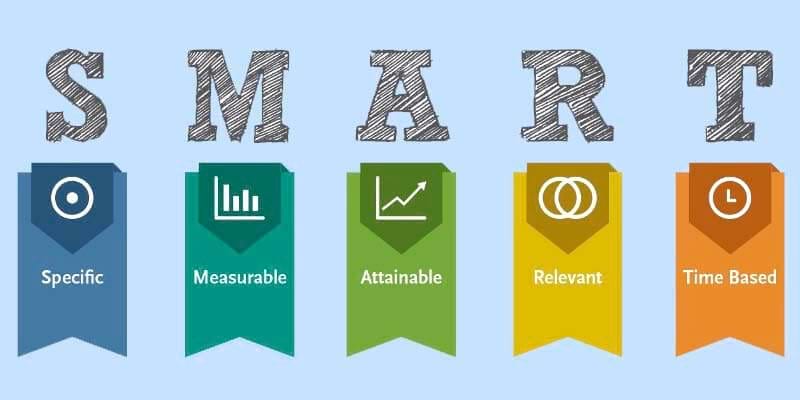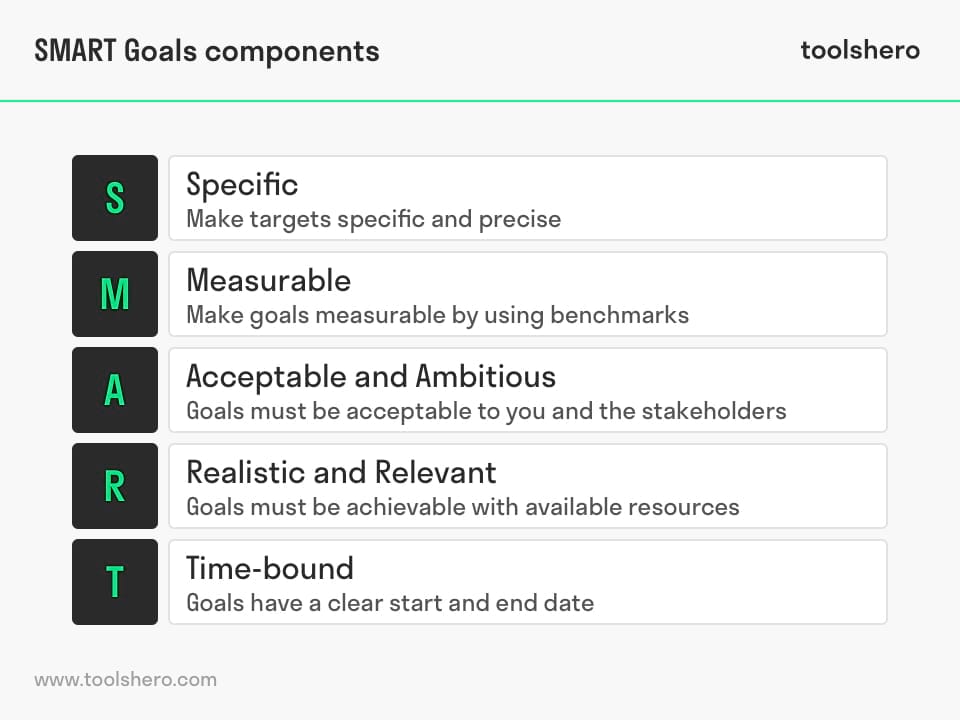SMART Goals explained

SMART Goals: this article explains the concept of SMART Goals in a practical way. Next to what it is (theory and acronym including examples), this article also highlights a Brief history, the use of this concept and a template / worksheet to reach your achievable goals and achieving success with your relevant goals. Enjoy Reading!
What are SMART Goals? The theory and concrete examples
Anyone who wants to pursue a personal goal, knows that is important to provide a good description of this specific goal. Empty slogans do not bring satisfactory results.
Making a concrete analysis in advance for your time management and setting goals will help you to get to the finishing line of your key performance and not to fall short. You will be motivated to achieve your goals within a certain time period.
A useful time management and goal setting method to achieve this is the so-called SMART Goals or simply SMART.
SMART Goals: the acronym explained
The smart acronym that stands for Specific, Measurable, Achievable, Relevant and Time Bound.
Peter Drucker is credited with the development of the smart acronym in his goal setting theory about ‘Management by Objectives‘.
A SMART goal gives direction to what you want to achieve. Setting these objectives and using the smart criteria will give a sense of direction to everyone who wants to achieve the relevant goal and it is highly likely that it can be really completed successfully. A well-formulated goal is easy to understand for everyone.
In order to write these type of goals, you will find an explanation of each of the letters below.

Figure 1 – The SMART GOALS acronym
Specific
A vague goal such as ‘our company wants to enhance its turnover’ indicates that the current situation is not satisfactory.
Apparently the turnover must be enhanced in order to achieve the goal. However, there is not a real plan to realize this goal within a certain time frame. So it is unclear for all the parties involved what they should do.
The objectives should therefore be formulated more precisely and specifically so that everyone knows what is expected of them. The objective must describe an observable action, behaviour or result, in order to achieve the goal and make it goal measurable. It helps if a quantitative value is linked to a number, amount or percentage.
By answering the so-call Wh- questions in advance, the goal will become more concrete:
- What do we wish to accomplish? (yield 20% more turnover than we did last year)
- Who are involved? (the marketing department, customer support, the office sales, field sales departments or team members)
- What resources are involved? (by making a € 50,000 budget available for the coming year)
- When is it going to happen? (from 1 January up to and including 31 December 2018)
- What parts of the goal are essential? (advertising should be deployed more actively and the field sales department must respond to enquiries in their field)
- Why is this goal important? (competition is increasing and in order to survive we need to become a key market player)
Measurable
Each SMART goal has a goal setting starting point as well as a finishing point and they are indications of the quality of the effort to be made.
A system, method and procedure must be mentioned which determines to what extent the target moment has been achieved (measurable goals).
Therefore, it is advisable when you set-up a goal measurable to have a benchmark and to determine a baseline measurement of the starting situation to measure and track progress:
- What was the turnover of the past year? (1.2 million in 2017)
- How do you know whether the goal has been achieved (20% of 1.2 million is 240,000.00)
- What efforts are required? (a good advertising campaign must be launched with good follow-up actions from the office sales and field sales departments)
- How can you measure progress? (by comparing the monthly and quarterly sales figures with the figures of the previous year)
Achievable (or Acceptable)
It must be achievable and acceptable) for you as well as for the group or the department. For managers it is important to set an achievable goal and create support for that goal among the employees. Only then the goal stands a chance of succeeding.
The support base will increase if employees are involved in the decision-making. This applies especially to short term objectives and SMART Goals.
If it turns out that 20% more turnover than the year before means that this is too ambitious and that this results in a decrease in job satisfaction, the percentage will have to be adjusted.
Therefore Achievable is also referred to as Ambitious; both go hand in hand and they should be in balance.
Ambition is great when it is a motivator. If it brings down motivation, then the ambition is too high and as a result it stretches everyone to the limit.
50 Personal Development And Personal Productivity Skills
Relevant
A realistic smart goal takes into account the practical situation and the work in which everyone is involved. It is impossible that everyone’s focus will be on the same goal all the time; after all, there are always other issues requiring attention and you need to fous on the sense of urgency if you want to achieve your goals.
For example urgent jobs, tasks that need to be carried out and unforeseen events. Furthermore, the goal must be relevant to those who are going to work on it. If the finance department is instructed to increase the turnover by 20% then it will probably come to nothing.
In addition, it must be ensured that the above-mentioned marketing, office sales and field sales departments actually have the time and manpower to focus on the achievable goal for a whole year.
Moreover, the goal must be challenging. If it isn’t, it has a demotivating effect on the people involved and little or no attention will be paid to the goal with the consequence that the goal will not be achieved.
Realistic is therefore about the feasibility of the goals. The objective must be challenging and bring benefits to the employees involved. They must also have the capacity, resources and authority to get started.
Time bound
Time bound is especially important that short-term objectives are formulated the SMART way. This is not always possible for long-term goals. Time bound and time based is often confused with measurable, but there is a clear difference between the two. Time bound is actually about the time that is allocated to reach the goal.
This type of smart goal therefore has a clear starting time and a clear end target date. A very tight deadline on the other hand has a demotivating effect and is therefore not acceptable.
The sub-question ‘when does it happen?’ has in fact been answered under the heading Specific: from 1 January up to and including 31 December 2018, work is to be carried out to increase sales by 20% and on 31 December 2018 this will have to result in 240,000 extra turnover.
One year from now is not a concrete goal, by setting a date and year for the smart goal, the organization can work towards this. Incidentally, a year is a long period. By dividing the smart goal into sub-goals that have a monthly deadline, everyone can work towards an interim completion.
This enhances motivation and makes it pleasant to continue the work even when faced with adverse conditions.
Brief history of SMART Goals
The first contextual event in the history happened in 1968. Edwin Locke published a seminal paper called “Toward a Theory of Task Motivation and Incentives”. In the paper, Locke established that appropriately set measurable smart goals do result in superior organizational performance.
It was Edwin Locke in the late 1960’s, who began his research of the power of setting goals and organizational performance. George T. Doran published in 1981 an article called “There’s a S.M.A.R.T. way to write management’s goals and objectives” and laid out the main principles of these Goals.
Use
It can be incorporated into (project management) tasks that managers assign to employees, project plans, business plans and marketing plans.
SMART can also be used in a time frame. It is very suitable for achieving weekly, monthly or quarterly goals. Sometimes the goal does not always have to be achieved, but works as a guideline that helps to maintain focus and increase the number of productive actions which can lead to better results.
Interim evaluations, verifications and adjustments are good and indicate that there is not always a need for a very rigid response.
After all, it is sometimes important to respond to changes from the environment with the right set of time and resources.
SMART Goals video
SMART Goals template and worksheet
To write your smart goal setting targets, you can use this ready-to-use template / worksheet in a .DOC format.
Download the SMART Goals template
This template is exclusively for our paying Toolshero members. Click here to see if a membership is something for you!It’s Your Turn
What do you think? What are your experiences with SMART? Do you recognize the practical explanation or do you have more suggestions? What are your success factors for good Goal formulation and achievement? How do you apply this within social media?
Share your experience and knowledge in the comments box below.
More information
- Bogue, R. L. (2005). Use SMART goals to launch management by objectives plan. Retrieved November, 15, 2010.
- Conzemius, A., & O’Neill, J. (2009). The power of SMART goals: Using goals to improve student learning. Solution Tree Press.
- Doran, G. T. (1981). There’sa SMART way to write management’s goals and objectives. Management review, 70(11), 35-36.
- Locke, E. A. (1968). Toward a theory of task motivation and incentives. Organizational behavior and human performance, 3(2), 157-189.
- Lawlor, K. B. (2012). Smart goals: How the application of smart goals can contribute to achievement of student learning outcomes. Developments in Business Simulation and Experiential Learning, 39.
How to cite this article:
Mulder, P. (2018). SMART Goals. Retrieved [insert date] from Toolshero: https://www.toolshero.com/personal-development/smart-goals/
Original publication date: 09/07/2018 | Last update: 01/05/2024
Add a link to this page on your website:
<a href=”https://www.toolshero.com/personal-development/smart-goals/”>Toolshero: SMART Goals</a>













2 responses to “SMART Goals explained”
Is the Action Plan mentioned about the tool/ resource that ties multiple SMART goals into a master plan? In other words, what resource should be used to align SMART goals from Sales/ Marketing/ New Products/ Customer Care personnel into a working, collaborative plan?
very fantastic and guiding